Management Accounting for Costs and Control - Detailed Analysis
VerifiedAdded on 2021/06/16
|14
|2536
|43
Homework Assignment
AI Summary
This assignment solution provides a detailed analysis of management accounting principles. It begins with job costing, including the creation of raw material, work-in-process, accounts payable, finished goods, and cost of goods sold accounts, along with related calculations. The solution then delves into process costing, presenting a production cost report, equivalent unit calculations, and cost assignments. A profit analysis is performed for different product grades, determining optimal processing decisions. The assignment continues with variance analysis, calculating material price and usage variances, as well as labor variances. A business report is included, discussing the purpose and application of variance analysis. Finally, the assignment concludes with a budget calculation, projecting costs and revenues over a period, and a discussion of the budgeting process.

Running head: MANAGEMENT ACCOUNTING FOR COSTS AND CONTROL
Management accounting for costs and control
Subject code
Student name and ID number
Assignment task number
Author note
Management accounting for costs and control
Subject code
Student name and ID number
Assignment task number
Author note
Paraphrase This Document
Need a fresh take? Get an instant paraphrase of this document with our AI Paraphraser
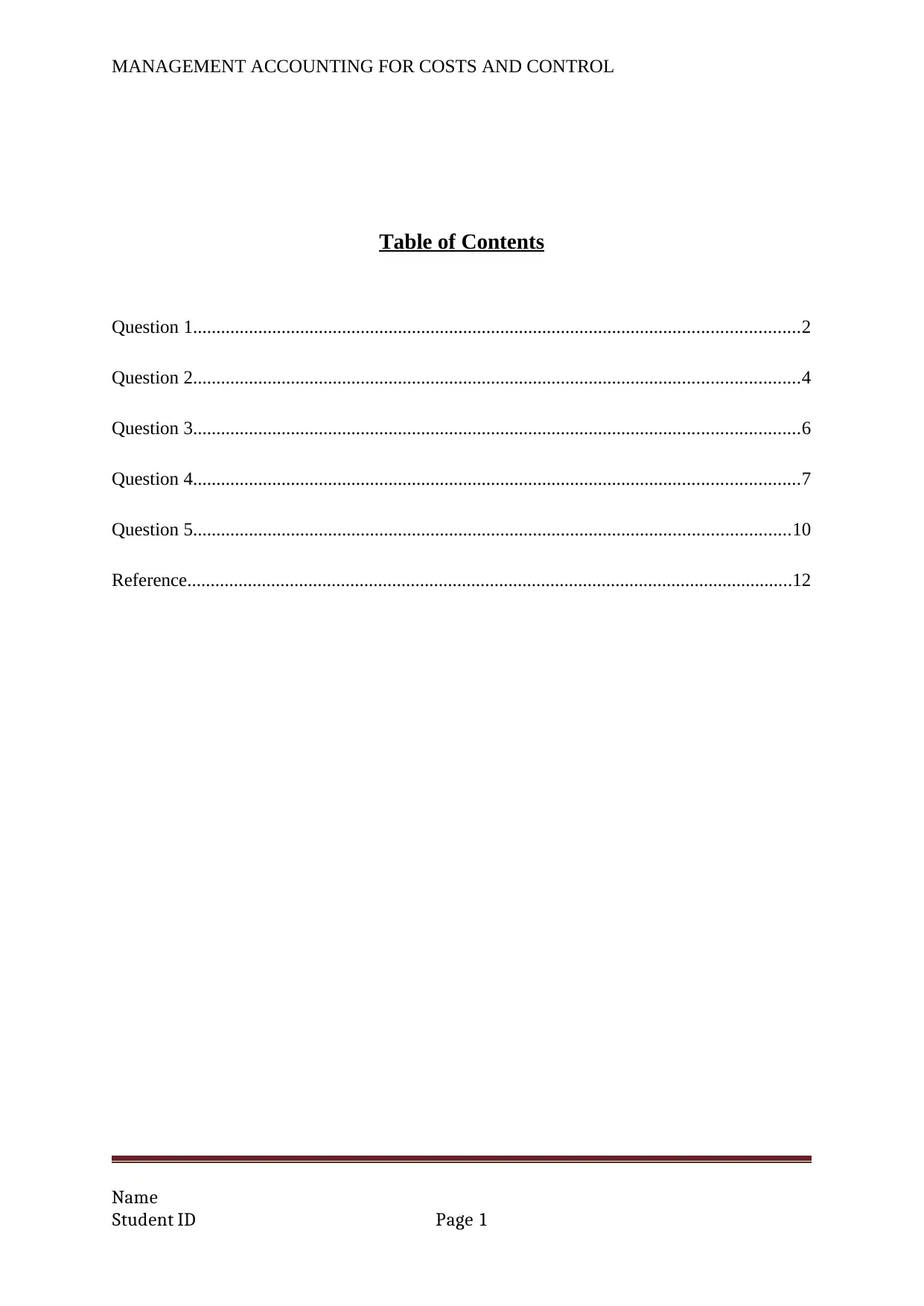
MANAGEMENT ACCOUNTING FOR COSTS AND CONTROL
Table of Contents
Question 1..................................................................................................................................2
Question 2..................................................................................................................................4
Question 3..................................................................................................................................6
Question 4..................................................................................................................................7
Question 5................................................................................................................................10
Reference..................................................................................................................................12
Name
Student ID Page 1
Table of Contents
Question 1..................................................................................................................................2
Question 2..................................................................................................................................4
Question 3..................................................................................................................................6
Question 4..................................................................................................................................7
Question 5................................................................................................................................10
Reference..................................................................................................................................12
Name
Student ID Page 1
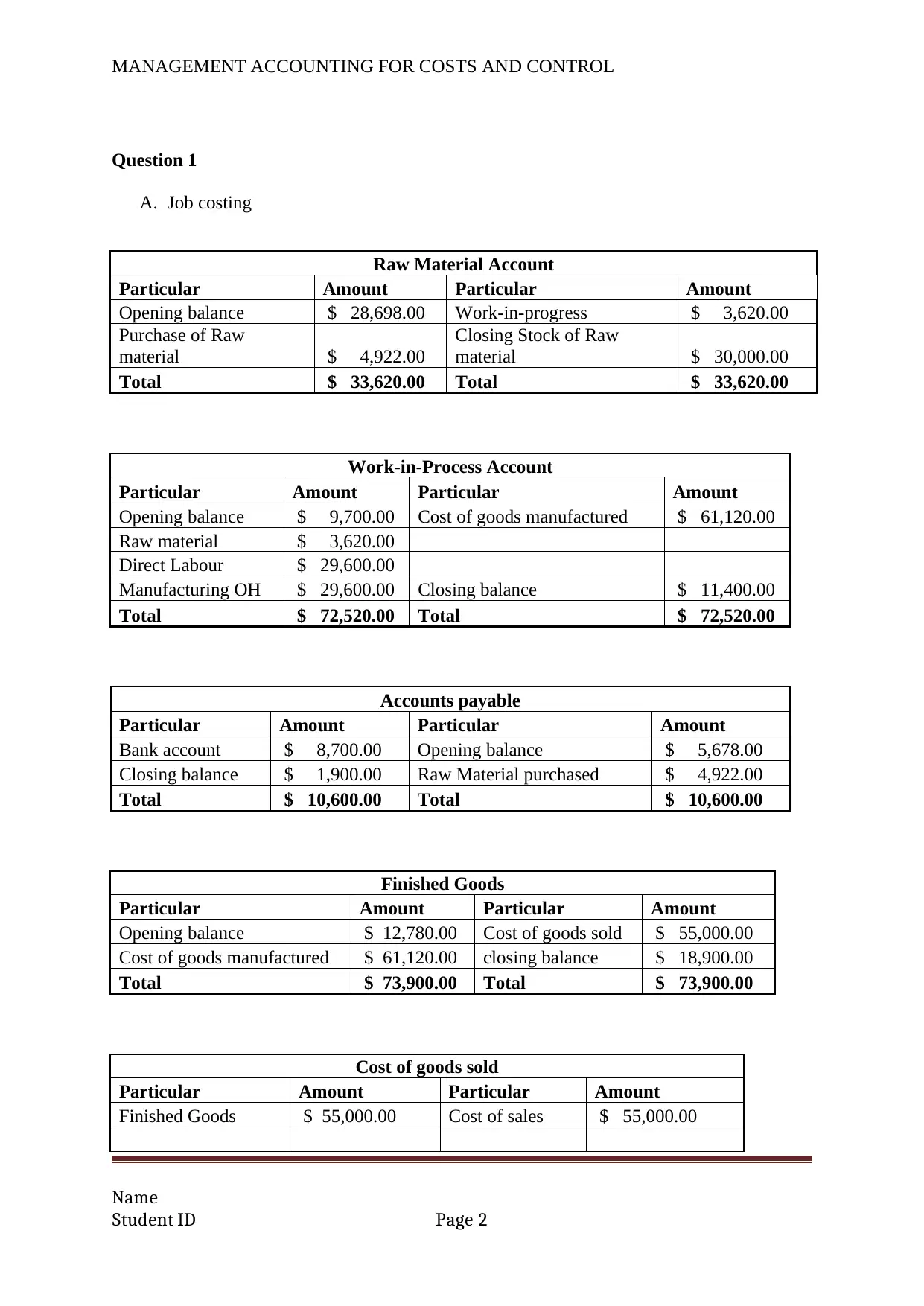
MANAGEMENT ACCOUNTING FOR COSTS AND CONTROL
Question 1
A. Job costing
Raw Material Account
Particular Amount Particular Amount
Opening balance $ 28,698.00 Work-in-progress $ 3,620.00
Purchase of Raw
material $ 4,922.00
Closing Stock of Raw
material $ 30,000.00
Total $ 33,620.00 Total $ 33,620.00
Work-in-Process Account
Particular Amount Particular Amount
Opening balance $ 9,700.00 Cost of goods manufactured $ 61,120.00
Raw material $ 3,620.00
Direct Labour $ 29,600.00
Manufacturing OH $ 29,600.00 Closing balance $ 11,400.00
Total $ 72,520.00 Total $ 72,520.00
Accounts payable
Particular Amount Particular Amount
Bank account $ 8,700.00 Opening balance $ 5,678.00
Closing balance $ 1,900.00 Raw Material purchased $ 4,922.00
Total $ 10,600.00 Total $ 10,600.00
Finished Goods
Particular Amount Particular Amount
Opening balance $ 12,780.00 Cost of goods sold $ 55,000.00
Cost of goods manufactured $ 61,120.00 closing balance $ 18,900.00
Total $ 73,900.00 Total $ 73,900.00
Cost of goods sold
Particular Amount Particular Amount
Finished Goods $ 55,000.00 Cost of sales $ 55,000.00
Name
Student ID Page 2
Question 1
A. Job costing
Raw Material Account
Particular Amount Particular Amount
Opening balance $ 28,698.00 Work-in-progress $ 3,620.00
Purchase of Raw
material $ 4,922.00
Closing Stock of Raw
material $ 30,000.00
Total $ 33,620.00 Total $ 33,620.00
Work-in-Process Account
Particular Amount Particular Amount
Opening balance $ 9,700.00 Cost of goods manufactured $ 61,120.00
Raw material $ 3,620.00
Direct Labour $ 29,600.00
Manufacturing OH $ 29,600.00 Closing balance $ 11,400.00
Total $ 72,520.00 Total $ 72,520.00
Accounts payable
Particular Amount Particular Amount
Bank account $ 8,700.00 Opening balance $ 5,678.00
Closing balance $ 1,900.00 Raw Material purchased $ 4,922.00
Total $ 10,600.00 Total $ 10,600.00
Finished Goods
Particular Amount Particular Amount
Opening balance $ 12,780.00 Cost of goods sold $ 55,000.00
Cost of goods manufactured $ 61,120.00 closing balance $ 18,900.00
Total $ 73,900.00 Total $ 73,900.00
Cost of goods sold
Particular Amount Particular Amount
Finished Goods $ 55,000.00 Cost of sales $ 55,000.00
Name
Student ID Page 2
⊘ This is a preview!⊘
Do you want full access?
Subscribe today to unlock all pages.

Trusted by 1+ million students worldwide
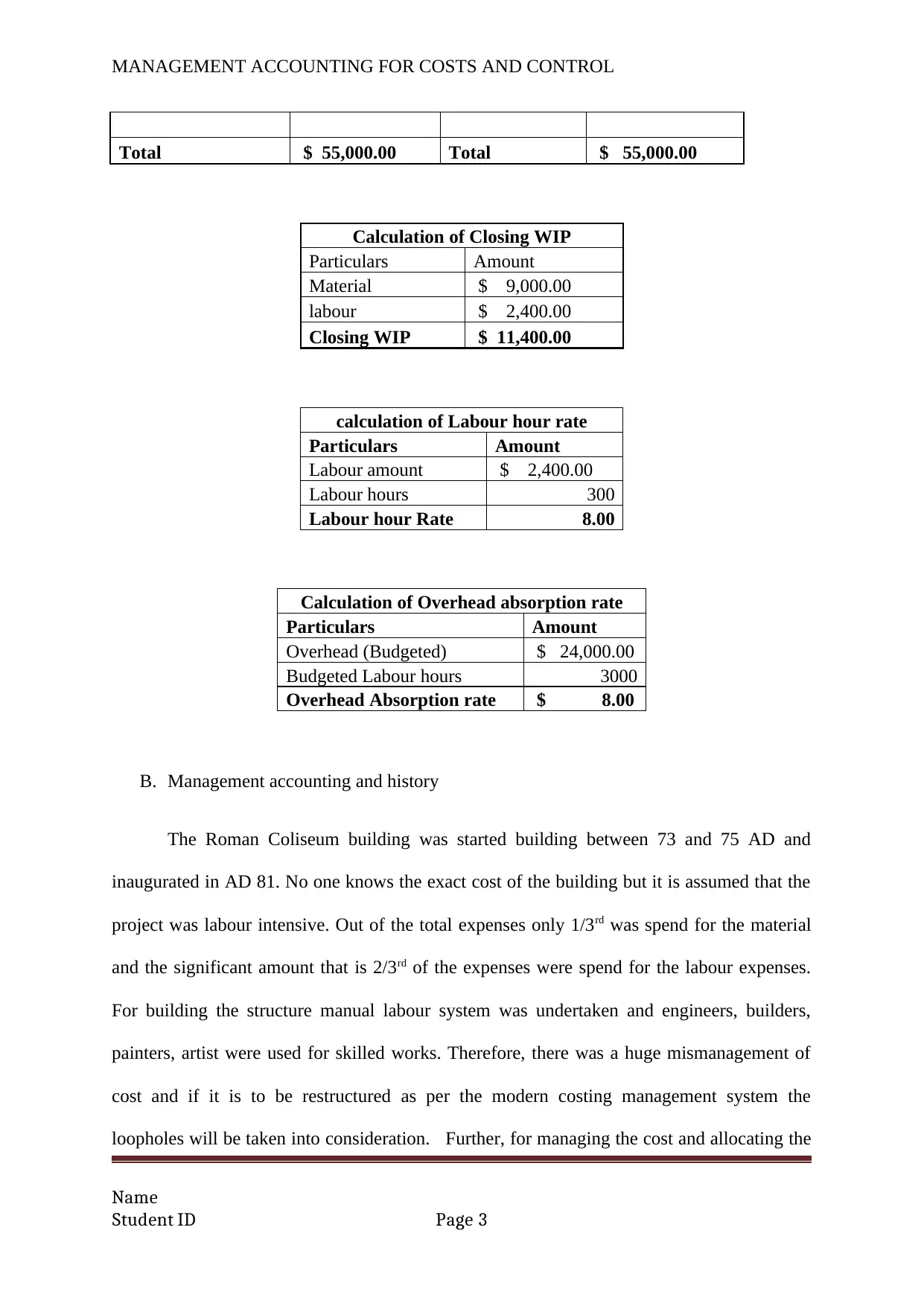
MANAGEMENT ACCOUNTING FOR COSTS AND CONTROL
Total $ 55,000.00 Total $ 55,000.00
Calculation of Closing WIP
Particulars Amount
Material $ 9,000.00
labour $ 2,400.00
Closing WIP $ 11,400.00
calculation of Labour hour rate
Particulars Amount
Labour amount $ 2,400.00
Labour hours 300
Labour hour Rate 8.00
Calculation of Overhead absorption rate
Particulars Amount
Overhead (Budgeted) $ 24,000.00
Budgeted Labour hours 3000
Overhead Absorption rate $ 8.00
B. Management accounting and history
The Roman Coliseum building was started building between 73 and 75 AD and
inaugurated in AD 81. No one knows the exact cost of the building but it is assumed that the
project was labour intensive. Out of the total expenses only 1/3rd was spend for the material
and the significant amount that is 2/3rd of the expenses were spend for the labour expenses.
For building the structure manual labour system was undertaken and engineers, builders,
painters, artist were used for skilled works. Therefore, there was a huge mismanagement of
cost and if it is to be restructured as per the modern costing management system the
loopholes will be taken into consideration. Further, for managing the cost and allocating the
Name
Student ID Page 3
Total $ 55,000.00 Total $ 55,000.00
Calculation of Closing WIP
Particulars Amount
Material $ 9,000.00
labour $ 2,400.00
Closing WIP $ 11,400.00
calculation of Labour hour rate
Particulars Amount
Labour amount $ 2,400.00
Labour hours 300
Labour hour Rate 8.00
Calculation of Overhead absorption rate
Particulars Amount
Overhead (Budgeted) $ 24,000.00
Budgeted Labour hours 3000
Overhead Absorption rate $ 8.00
B. Management accounting and history
The Roman Coliseum building was started building between 73 and 75 AD and
inaugurated in AD 81. No one knows the exact cost of the building but it is assumed that the
project was labour intensive. Out of the total expenses only 1/3rd was spend for the material
and the significant amount that is 2/3rd of the expenses were spend for the labour expenses.
For building the structure manual labour system was undertaken and engineers, builders,
painters, artist were used for skilled works. Therefore, there was a huge mismanagement of
cost and if it is to be restructured as per the modern costing management system the
loopholes will be taken into consideration. Further, for managing the cost and allocating the
Name
Student ID Page 3
Paraphrase This Document
Need a fresh take? Get an instant paraphrase of this document with our AI Paraphraser
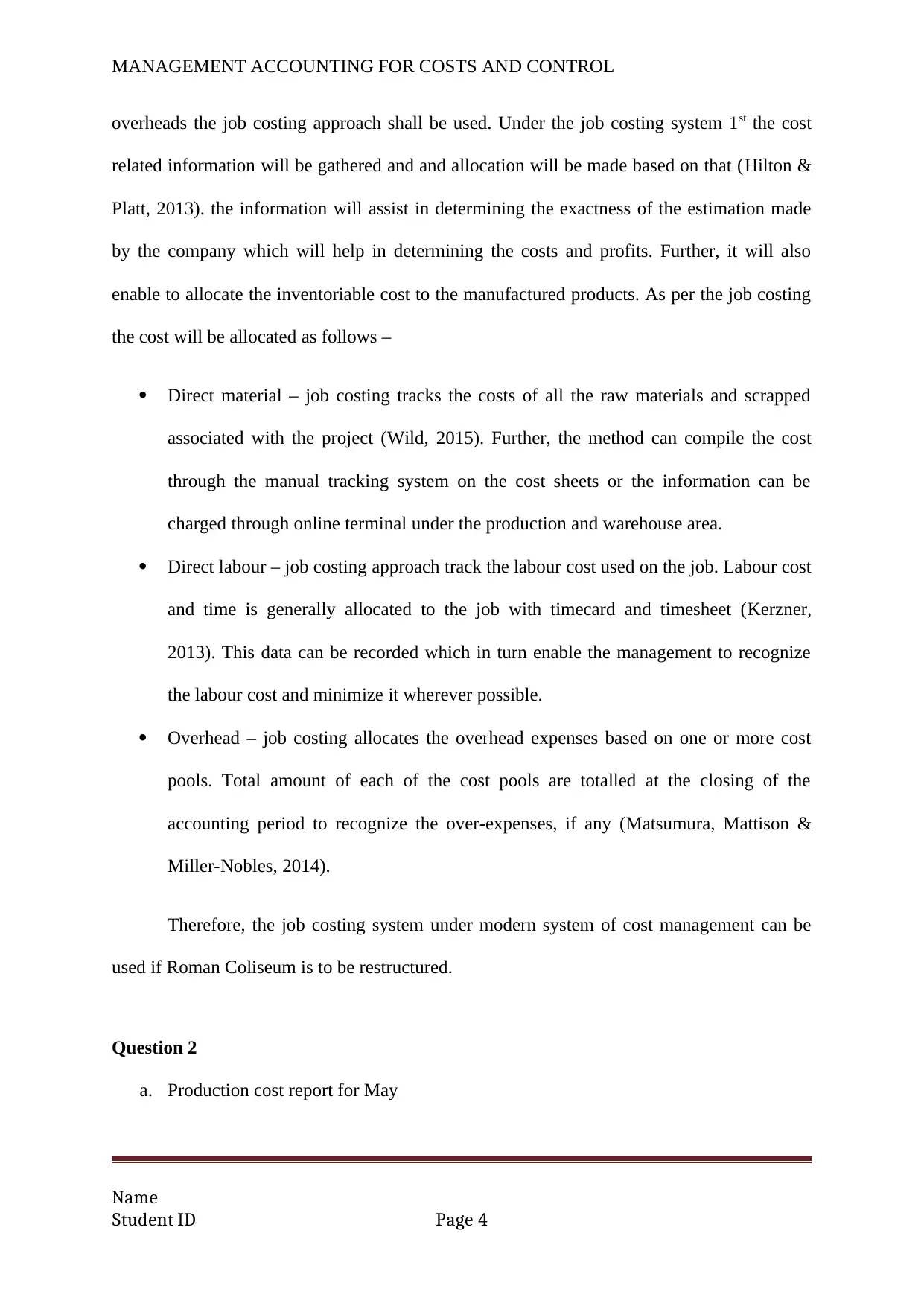
MANAGEMENT ACCOUNTING FOR COSTS AND CONTROL
overheads the job costing approach shall be used. Under the job costing system 1st the cost
related information will be gathered and and allocation will be made based on that (Hilton &
Platt, 2013). the information will assist in determining the exactness of the estimation made
by the company which will help in determining the costs and profits. Further, it will also
enable to allocate the inventoriable cost to the manufactured products. As per the job costing
the cost will be allocated as follows –
Direct material – job costing tracks the costs of all the raw materials and scrapped
associated with the project (Wild, 2015). Further, the method can compile the cost
through the manual tracking system on the cost sheets or the information can be
charged through online terminal under the production and warehouse area.
Direct labour – job costing approach track the labour cost used on the job. Labour cost
and time is generally allocated to the job with timecard and timesheet (Kerzner,
2013). This data can be recorded which in turn enable the management to recognize
the labour cost and minimize it wherever possible.
Overhead – job costing allocates the overhead expenses based on one or more cost
pools. Total amount of each of the cost pools are totalled at the closing of the
accounting period to recognize the over-expenses, if any (Matsumura, Mattison &
Miller-Nobles, 2014).
Therefore, the job costing system under modern system of cost management can be
used if Roman Coliseum is to be restructured.
Question 2
a. Production cost report for May
Name
Student ID Page 4
overheads the job costing approach shall be used. Under the job costing system 1st the cost
related information will be gathered and and allocation will be made based on that (Hilton &
Platt, 2013). the information will assist in determining the exactness of the estimation made
by the company which will help in determining the costs and profits. Further, it will also
enable to allocate the inventoriable cost to the manufactured products. As per the job costing
the cost will be allocated as follows –
Direct material – job costing tracks the costs of all the raw materials and scrapped
associated with the project (Wild, 2015). Further, the method can compile the cost
through the manual tracking system on the cost sheets or the information can be
charged through online terminal under the production and warehouse area.
Direct labour – job costing approach track the labour cost used on the job. Labour cost
and time is generally allocated to the job with timecard and timesheet (Kerzner,
2013). This data can be recorded which in turn enable the management to recognize
the labour cost and minimize it wherever possible.
Overhead – job costing allocates the overhead expenses based on one or more cost
pools. Total amount of each of the cost pools are totalled at the closing of the
accounting period to recognize the over-expenses, if any (Matsumura, Mattison &
Miller-Nobles, 2014).
Therefore, the job costing system under modern system of cost management can be
used if Roman Coliseum is to be restructured.
Question 2
a. Production cost report for May
Name
Student ID Page 4
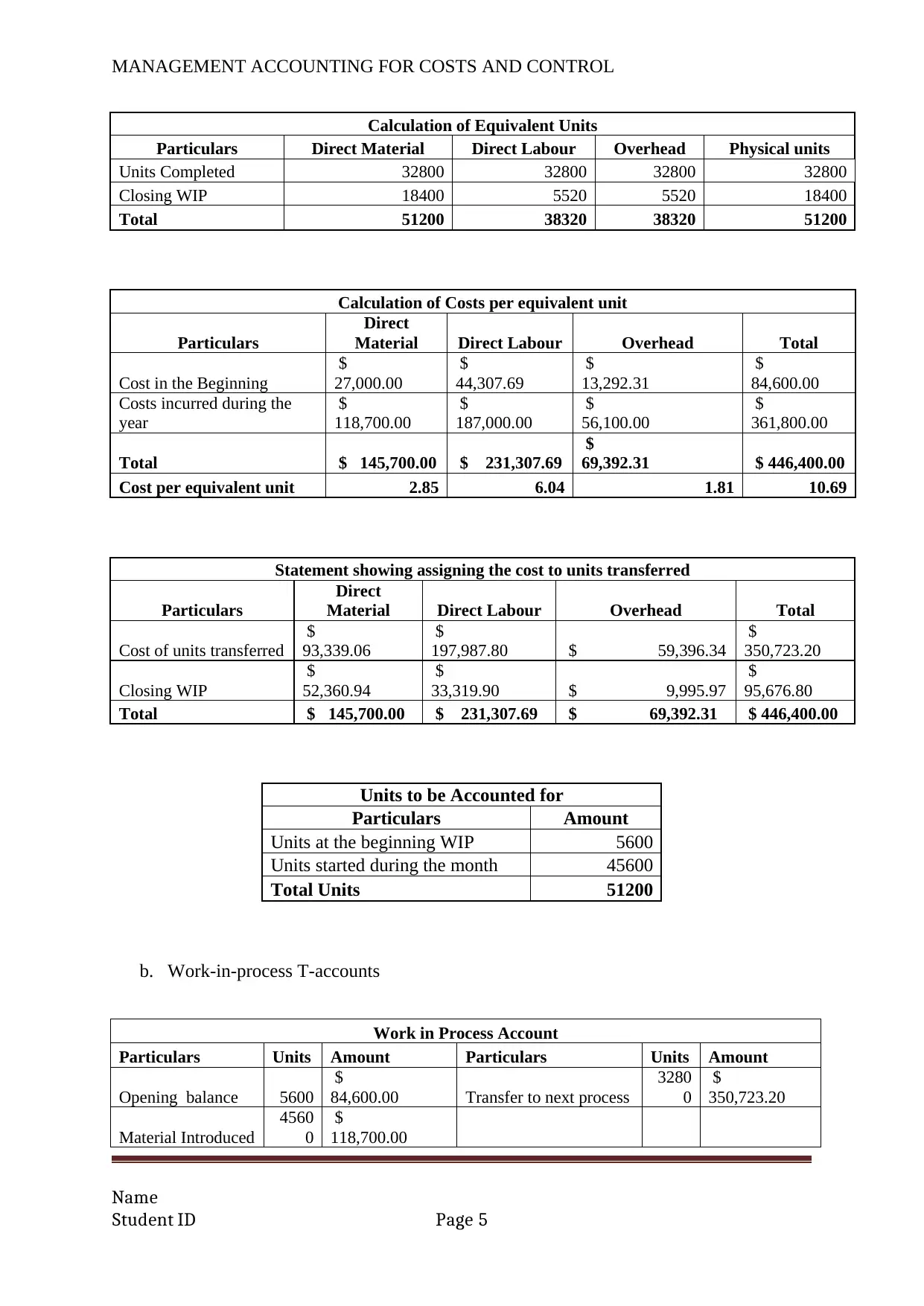
MANAGEMENT ACCOUNTING FOR COSTS AND CONTROL
Calculation of Equivalent Units
Particulars Direct Material Direct Labour Overhead Physical units
Units Completed 32800 32800 32800 32800
Closing WIP 18400 5520 5520 18400
Total 51200 38320 38320 51200
Calculation of Costs per equivalent unit
Particulars
Direct
Material Direct Labour Overhead Total
Cost in the Beginning
$
27,000.00
$
44,307.69
$
13,292.31
$
84,600.00
Costs incurred during the
year
$
118,700.00
$
187,000.00
$
56,100.00
$
361,800.00
Total $ 145,700.00 $ 231,307.69
$
69,392.31 $ 446,400.00
Cost per equivalent unit 2.85 6.04 1.81 10.69
Statement showing assigning the cost to units transferred
Particulars
Direct
Material Direct Labour Overhead Total
Cost of units transferred
$
93,339.06
$
197,987.80 $ 59,396.34
$
350,723.20
Closing WIP
$
52,360.94
$
33,319.90 $ 9,995.97
$
95,676.80
Total $ 145,700.00 $ 231,307.69 $ 69,392.31 $ 446,400.00
Units to be Accounted for
Particulars Amount
Units at the beginning WIP 5600
Units started during the month 45600
Total Units 51200
b. Work-in-process T-accounts
Work in Process Account
Particulars Units Amount Particulars Units Amount
Opening balance 5600
$
84,600.00 Transfer to next process
3280
0
$
350,723.20
Material Introduced
4560
0
$
118,700.00
Name
Student ID Page 5
Calculation of Equivalent Units
Particulars Direct Material Direct Labour Overhead Physical units
Units Completed 32800 32800 32800 32800
Closing WIP 18400 5520 5520 18400
Total 51200 38320 38320 51200
Calculation of Costs per equivalent unit
Particulars
Direct
Material Direct Labour Overhead Total
Cost in the Beginning
$
27,000.00
$
44,307.69
$
13,292.31
$
84,600.00
Costs incurred during the
year
$
118,700.00
$
187,000.00
$
56,100.00
$
361,800.00
Total $ 145,700.00 $ 231,307.69
$
69,392.31 $ 446,400.00
Cost per equivalent unit 2.85 6.04 1.81 10.69
Statement showing assigning the cost to units transferred
Particulars
Direct
Material Direct Labour Overhead Total
Cost of units transferred
$
93,339.06
$
197,987.80 $ 59,396.34
$
350,723.20
Closing WIP
$
52,360.94
$
33,319.90 $ 9,995.97
$
95,676.80
Total $ 145,700.00 $ 231,307.69 $ 69,392.31 $ 446,400.00
Units to be Accounted for
Particulars Amount
Units at the beginning WIP 5600
Units started during the month 45600
Total Units 51200
b. Work-in-process T-accounts
Work in Process Account
Particulars Units Amount Particulars Units Amount
Opening balance 5600
$
84,600.00 Transfer to next process
3280
0
$
350,723.20
Material Introduced
4560
0
$
118,700.00
Name
Student ID Page 5
⊘ This is a preview!⊘
Do you want full access?
Subscribe today to unlock all pages.

Trusted by 1+ million students worldwide
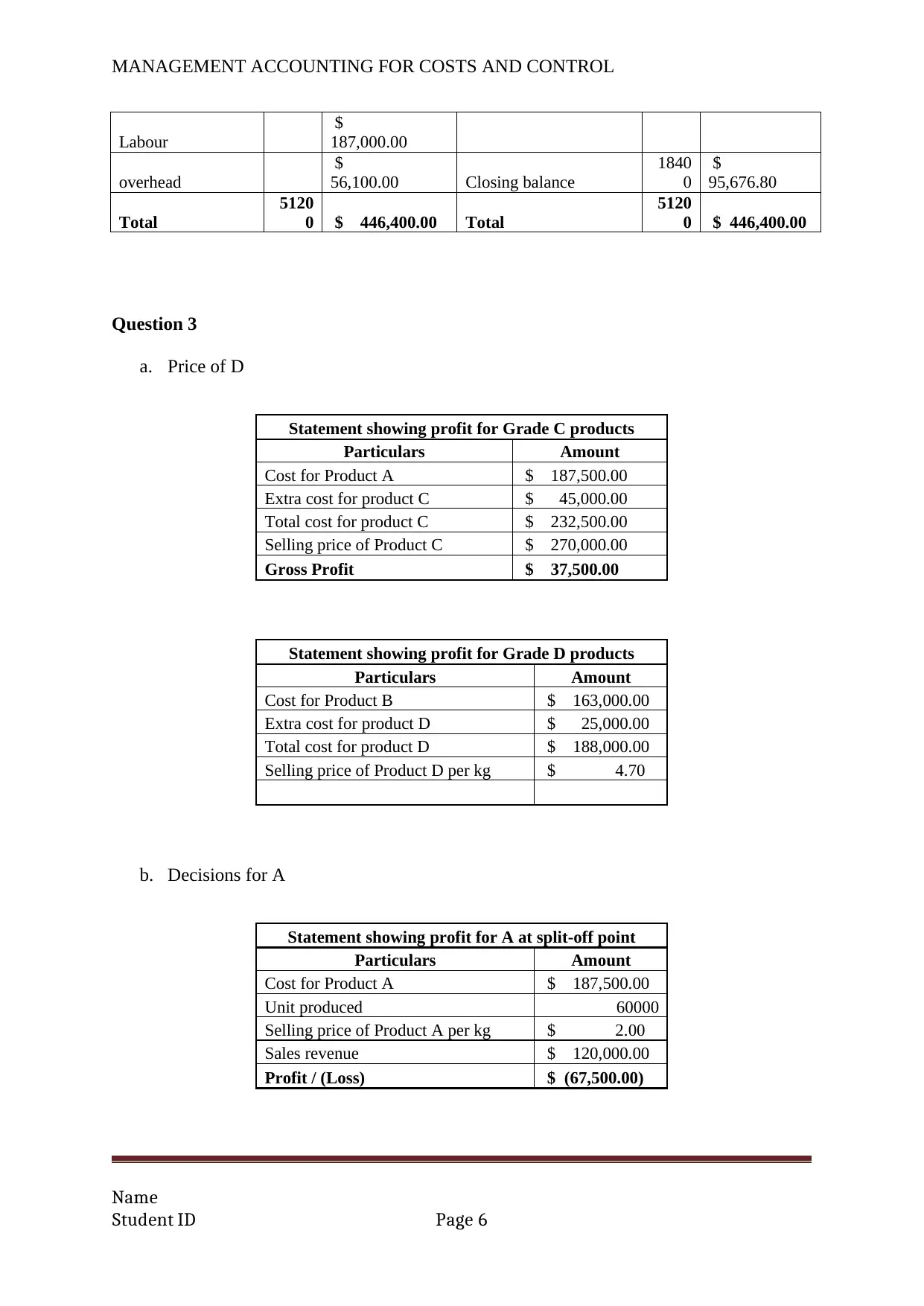
MANAGEMENT ACCOUNTING FOR COSTS AND CONTROL
Labour
$
187,000.00
overhead
$
56,100.00 Closing balance
1840
0
$
95,676.80
Total
5120
0 $ 446,400.00 Total
5120
0 $ 446,400.00
Question 3
a. Price of D
Statement showing profit for Grade C products
Particulars Amount
Cost for Product A $ 187,500.00
Extra cost for product C $ 45,000.00
Total cost for product C $ 232,500.00
Selling price of Product C $ 270,000.00
Gross Profit $ 37,500.00
Statement showing profit for Grade D products
Particulars Amount
Cost for Product B $ 163,000.00
Extra cost for product D $ 25,000.00
Total cost for product D $ 188,000.00
Selling price of Product D per kg $ 4.70
b. Decisions for A
Statement showing profit for A at split-off point
Particulars Amount
Cost for Product A $ 187,500.00
Unit produced 60000
Selling price of Product A per kg $ 2.00
Sales revenue $ 120,000.00
Profit / (Loss) $ (67,500.00)
Name
Student ID Page 6
Labour
$
187,000.00
overhead
$
56,100.00 Closing balance
1840
0
$
95,676.80
Total
5120
0 $ 446,400.00 Total
5120
0 $ 446,400.00
Question 3
a. Price of D
Statement showing profit for Grade C products
Particulars Amount
Cost for Product A $ 187,500.00
Extra cost for product C $ 45,000.00
Total cost for product C $ 232,500.00
Selling price of Product C $ 270,000.00
Gross Profit $ 37,500.00
Statement showing profit for Grade D products
Particulars Amount
Cost for Product B $ 163,000.00
Extra cost for product D $ 25,000.00
Total cost for product D $ 188,000.00
Selling price of Product D per kg $ 4.70
b. Decisions for A
Statement showing profit for A at split-off point
Particulars Amount
Cost for Product A $ 187,500.00
Unit produced 60000
Selling price of Product A per kg $ 2.00
Sales revenue $ 120,000.00
Profit / (Loss) $ (67,500.00)
Name
Student ID Page 6
Paraphrase This Document
Need a fresh take? Get an instant paraphrase of this document with our AI Paraphraser

MANAGEMENT ACCOUNTING FOR COSTS AND CONTROL
From the above calculation it is recognized that when the product A is processed to
produce product C for additional cost of $ 45,000, the product C can be sold for $ 4.50 per kg
and the profit will be $ 37,500. However, if product A is sold at the split-off point at $ 2 per
kg then the cost attributable to the product will be $ 187,500. Therefore, the amount of loss
will be $ 67,500. Therefore the difference will be ($ 37500)-(-$ 67500) = $ 105,000.
Therefore, A must be considered for further processing to produce product C.
Question 4
a. Variance analysis
Material price variance
Statement showing calculation of material price variance
Particulars Amount
Standard unit price of material $ 7.00
Actual Quantity purchased price $ 2,036,000.00
Standard price allowed for actual production $ 1,848,000.00
Material Purchase price variance (unfavourable) (UF) $ 188,000.00
Material usage variance
Statement showing calculation of material usage variance
Particulars Kg
Standard quantity for material per unit 12
Unit produced 22000
Standard quantity allowed for actual production 264000
Actual quantity used for actual production 203000
Material usage variance (Favourable) 61000
Actual direct labour rate per hour
Calculation showing actual direct labour rate
Particulars Amount
Name
Student ID Page 7
From the above calculation it is recognized that when the product A is processed to
produce product C for additional cost of $ 45,000, the product C can be sold for $ 4.50 per kg
and the profit will be $ 37,500. However, if product A is sold at the split-off point at $ 2 per
kg then the cost attributable to the product will be $ 187,500. Therefore, the amount of loss
will be $ 67,500. Therefore the difference will be ($ 37500)-(-$ 67500) = $ 105,000.
Therefore, A must be considered for further processing to produce product C.
Question 4
a. Variance analysis
Material price variance
Statement showing calculation of material price variance
Particulars Amount
Standard unit price of material $ 7.00
Actual Quantity purchased price $ 2,036,000.00
Standard price allowed for actual production $ 1,848,000.00
Material Purchase price variance (unfavourable) (UF) $ 188,000.00
Material usage variance
Statement showing calculation of material usage variance
Particulars Kg
Standard quantity for material per unit 12
Unit produced 22000
Standard quantity allowed for actual production 264000
Actual quantity used for actual production 203000
Material usage variance (Favourable) 61000
Actual direct labour rate per hour
Calculation showing actual direct labour rate
Particulars Amount
Name
Student ID Page 7
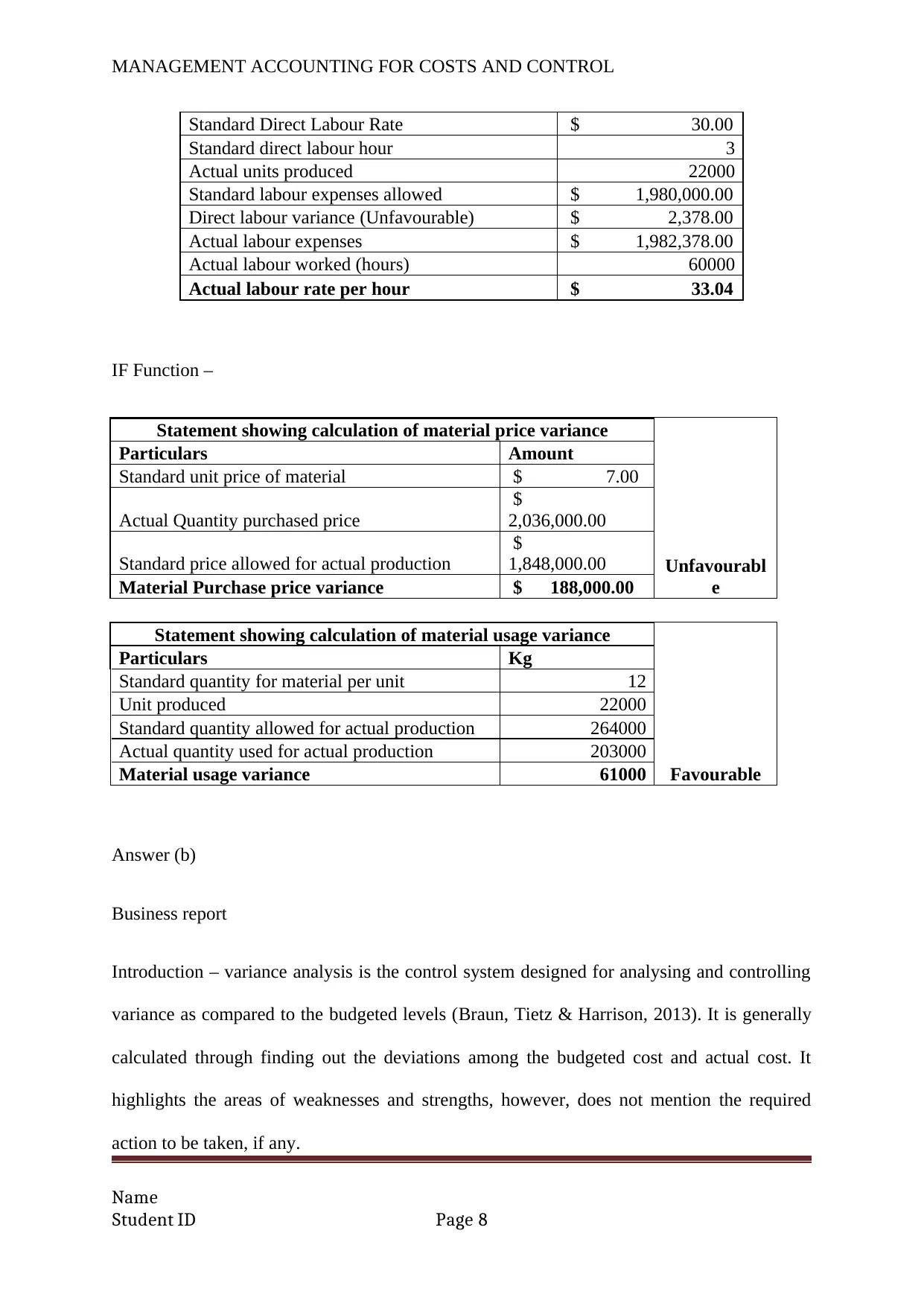
MANAGEMENT ACCOUNTING FOR COSTS AND CONTROL
Standard Direct Labour Rate $ 30.00
Standard direct labour hour 3
Actual units produced 22000
Standard labour expenses allowed $ 1,980,000.00
Direct labour variance (Unfavourable) $ 2,378.00
Actual labour expenses $ 1,982,378.00
Actual labour worked (hours) 60000
Actual labour rate per hour $ 33.04
IF Function –
Statement showing calculation of material price variance
Unfavourabl
e
Particulars Amount
Standard unit price of material $ 7.00
Actual Quantity purchased price
$
2,036,000.00
Standard price allowed for actual production
$
1,848,000.00
Material Purchase price variance $ 188,000.00
Statement showing calculation of material usage variance
Favourable
Particulars Kg
Standard quantity for material per unit 12
Unit produced 22000
Standard quantity allowed for actual production 264000
Actual quantity used for actual production 203000
Material usage variance 61000
Answer (b)
Business report
Introduction – variance analysis is the control system designed for analysing and controlling
variance as compared to the budgeted levels (Braun, Tietz & Harrison, 2013). It is generally
calculated through finding out the deviations among the budgeted cost and actual cost. It
highlights the areas of weaknesses and strengths, however, does not mention the required
action to be taken, if any.
Name
Student ID Page 8
Standard Direct Labour Rate $ 30.00
Standard direct labour hour 3
Actual units produced 22000
Standard labour expenses allowed $ 1,980,000.00
Direct labour variance (Unfavourable) $ 2,378.00
Actual labour expenses $ 1,982,378.00
Actual labour worked (hours) 60000
Actual labour rate per hour $ 33.04
IF Function –
Statement showing calculation of material price variance
Unfavourabl
e
Particulars Amount
Standard unit price of material $ 7.00
Actual Quantity purchased price
$
2,036,000.00
Standard price allowed for actual production
$
1,848,000.00
Material Purchase price variance $ 188,000.00
Statement showing calculation of material usage variance
Favourable
Particulars Kg
Standard quantity for material per unit 12
Unit produced 22000
Standard quantity allowed for actual production 264000
Actual quantity used for actual production 203000
Material usage variance 61000
Answer (b)
Business report
Introduction – variance analysis is the control system designed for analysing and controlling
variance as compared to the budgeted levels (Braun, Tietz & Harrison, 2013). It is generally
calculated through finding out the deviations among the budgeted cost and actual cost. It
highlights the areas of weaknesses and strengths, however, does not mention the required
action to be taken, if any.
Name
Student ID Page 8
⊘ This is a preview!⊘
Do you want full access?
Subscribe today to unlock all pages.

Trusted by 1+ million students worldwide
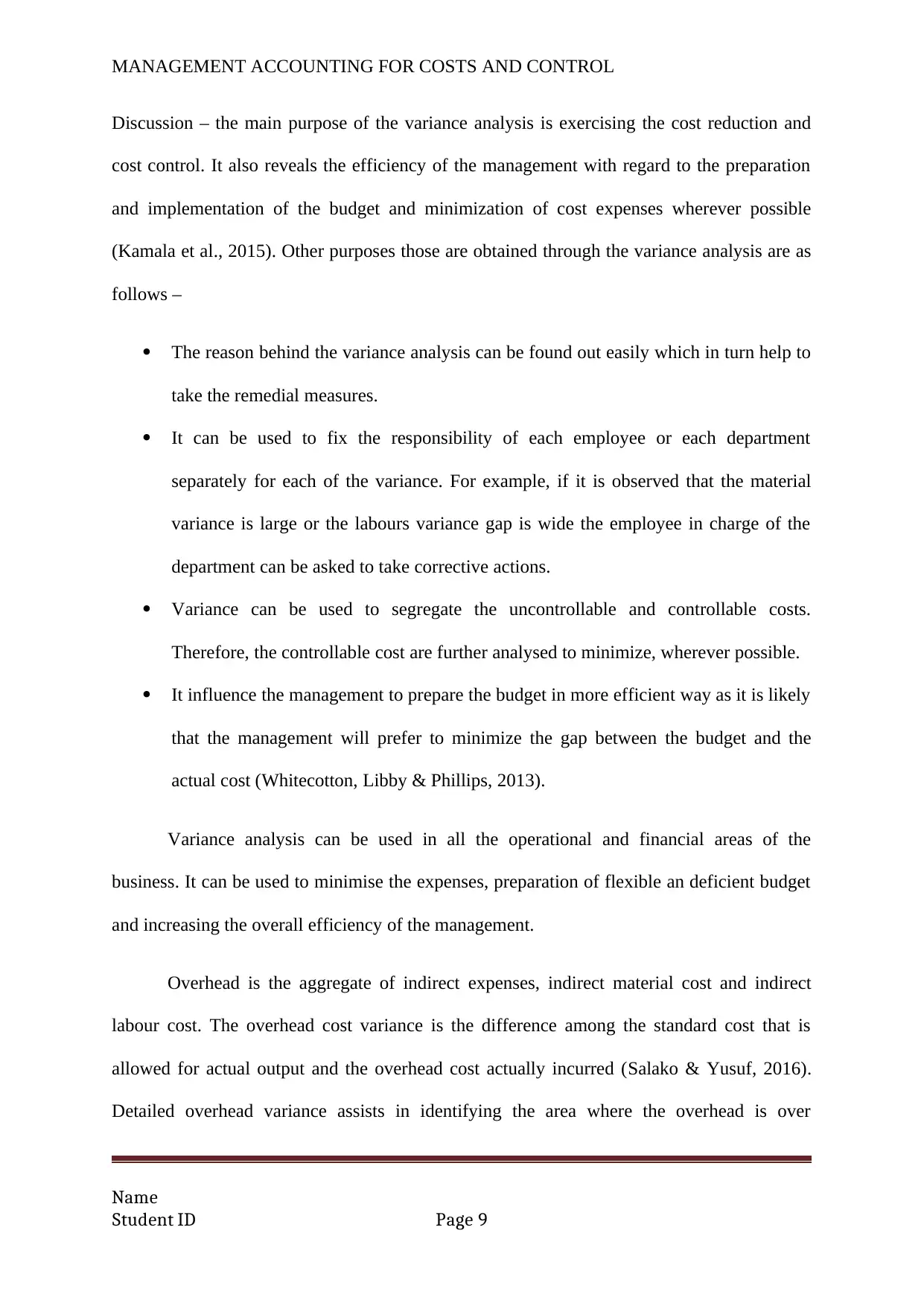
MANAGEMENT ACCOUNTING FOR COSTS AND CONTROL
Discussion – the main purpose of the variance analysis is exercising the cost reduction and
cost control. It also reveals the efficiency of the management with regard to the preparation
and implementation of the budget and minimization of cost expenses wherever possible
(Kamala et al., 2015). Other purposes those are obtained through the variance analysis are as
follows –
The reason behind the variance analysis can be found out easily which in turn help to
take the remedial measures.
It can be used to fix the responsibility of each employee or each department
separately for each of the variance. For example, if it is observed that the material
variance is large or the labours variance gap is wide the employee in charge of the
department can be asked to take corrective actions.
Variance can be used to segregate the uncontrollable and controllable costs.
Therefore, the controllable cost are further analysed to minimize, wherever possible.
It influence the management to prepare the budget in more efficient way as it is likely
that the management will prefer to minimize the gap between the budget and the
actual cost (Whitecotton, Libby & Phillips, 2013).
Variance analysis can be used in all the operational and financial areas of the
business. It can be used to minimise the expenses, preparation of flexible an deficient budget
and increasing the overall efficiency of the management.
Overhead is the aggregate of indirect expenses, indirect material cost and indirect
labour cost. The overhead cost variance is the difference among the standard cost that is
allowed for actual output and the overhead cost actually incurred (Salako & Yusuf, 2016).
Detailed overhead variance assists in identifying the area where the overhead is over
Name
Student ID Page 9
Discussion – the main purpose of the variance analysis is exercising the cost reduction and
cost control. It also reveals the efficiency of the management with regard to the preparation
and implementation of the budget and minimization of cost expenses wherever possible
(Kamala et al., 2015). Other purposes those are obtained through the variance analysis are as
follows –
The reason behind the variance analysis can be found out easily which in turn help to
take the remedial measures.
It can be used to fix the responsibility of each employee or each department
separately for each of the variance. For example, if it is observed that the material
variance is large or the labours variance gap is wide the employee in charge of the
department can be asked to take corrective actions.
Variance can be used to segregate the uncontrollable and controllable costs.
Therefore, the controllable cost are further analysed to minimize, wherever possible.
It influence the management to prepare the budget in more efficient way as it is likely
that the management will prefer to minimize the gap between the budget and the
actual cost (Whitecotton, Libby & Phillips, 2013).
Variance analysis can be used in all the operational and financial areas of the
business. It can be used to minimise the expenses, preparation of flexible an deficient budget
and increasing the overall efficiency of the management.
Overhead is the aggregate of indirect expenses, indirect material cost and indirect
labour cost. The overhead cost variance is the difference among the standard cost that is
allowed for actual output and the overhead cost actually incurred (Salako & Yusuf, 2016).
Detailed overhead variance assists in identifying the area where the overhead is over
Name
Student ID Page 9
Paraphrase This Document
Need a fresh take? Get an instant paraphrase of this document with our AI Paraphraser
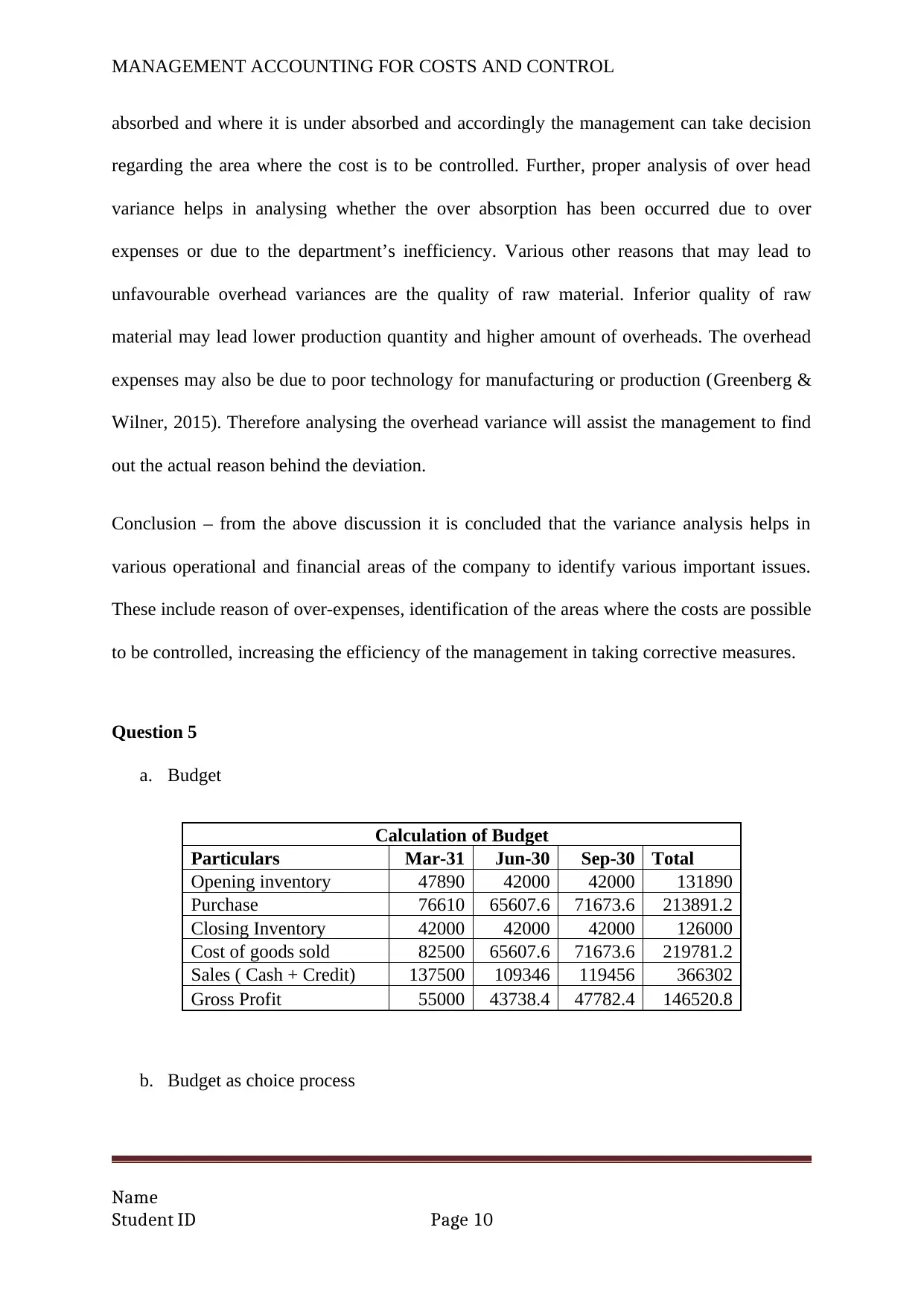
MANAGEMENT ACCOUNTING FOR COSTS AND CONTROL
absorbed and where it is under absorbed and accordingly the management can take decision
regarding the area where the cost is to be controlled. Further, proper analysis of over head
variance helps in analysing whether the over absorption has been occurred due to over
expenses or due to the department’s inefficiency. Various other reasons that may lead to
unfavourable overhead variances are the quality of raw material. Inferior quality of raw
material may lead lower production quantity and higher amount of overheads. The overhead
expenses may also be due to poor technology for manufacturing or production (Greenberg &
Wilner, 2015). Therefore analysing the overhead variance will assist the management to find
out the actual reason behind the deviation.
Conclusion – from the above discussion it is concluded that the variance analysis helps in
various operational and financial areas of the company to identify various important issues.
These include reason of over-expenses, identification of the areas where the costs are possible
to be controlled, increasing the efficiency of the management in taking corrective measures.
Question 5
a. Budget
Calculation of Budget
Particulars Mar-31 Jun-30 Sep-30 Total
Opening inventory 47890 42000 42000 131890
Purchase 76610 65607.6 71673.6 213891.2
Closing Inventory 42000 42000 42000 126000
Cost of goods sold 82500 65607.6 71673.6 219781.2
Sales ( Cash + Credit) 137500 109346 119456 366302
Gross Profit 55000 43738.4 47782.4 146520.8
b. Budget as choice process
Name
Student ID Page 10
absorbed and where it is under absorbed and accordingly the management can take decision
regarding the area where the cost is to be controlled. Further, proper analysis of over head
variance helps in analysing whether the over absorption has been occurred due to over
expenses or due to the department’s inefficiency. Various other reasons that may lead to
unfavourable overhead variances are the quality of raw material. Inferior quality of raw
material may lead lower production quantity and higher amount of overheads. The overhead
expenses may also be due to poor technology for manufacturing or production (Greenberg &
Wilner, 2015). Therefore analysing the overhead variance will assist the management to find
out the actual reason behind the deviation.
Conclusion – from the above discussion it is concluded that the variance analysis helps in
various operational and financial areas of the company to identify various important issues.
These include reason of over-expenses, identification of the areas where the costs are possible
to be controlled, increasing the efficiency of the management in taking corrective measures.
Question 5
a. Budget
Calculation of Budget
Particulars Mar-31 Jun-30 Sep-30 Total
Opening inventory 47890 42000 42000 131890
Purchase 76610 65607.6 71673.6 213891.2
Closing Inventory 42000 42000 42000 126000
Cost of goods sold 82500 65607.6 71673.6 219781.2
Sales ( Cash + Credit) 137500 109346 119456 366302
Gross Profit 55000 43738.4 47782.4 146520.8
b. Budget as choice process
Name
Student ID Page 10
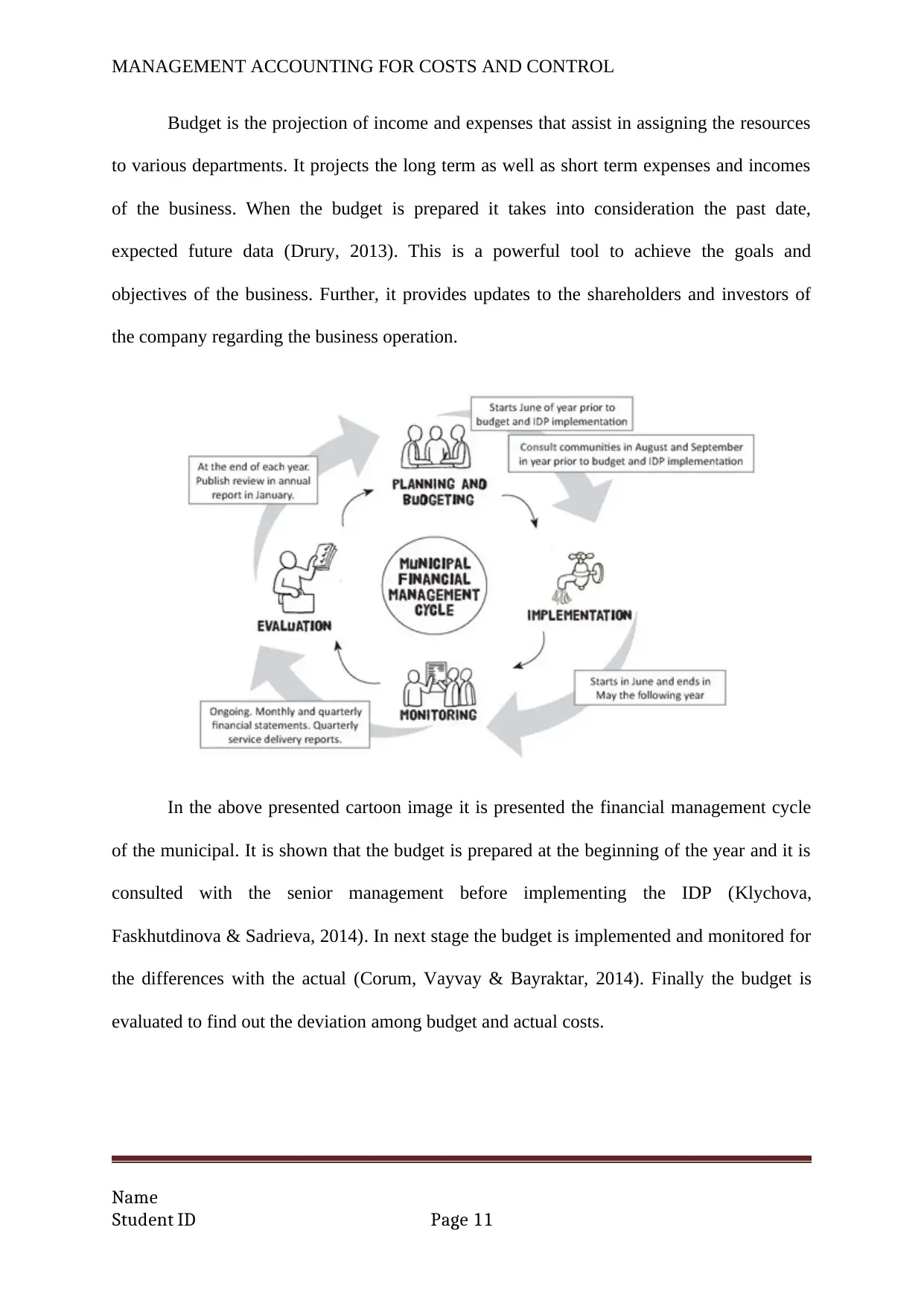
MANAGEMENT ACCOUNTING FOR COSTS AND CONTROL
Budget is the projection of income and expenses that assist in assigning the resources
to various departments. It projects the long term as well as short term expenses and incomes
of the business. When the budget is prepared it takes into consideration the past date,
expected future data (Drury, 2013). This is a powerful tool to achieve the goals and
objectives of the business. Further, it provides updates to the shareholders and investors of
the company regarding the business operation.
In the above presented cartoon image it is presented the financial management cycle
of the municipal. It is shown that the budget is prepared at the beginning of the year and it is
consulted with the senior management before implementing the IDP (Klychova,
Faskhutdinova & Sadrieva, 2014). In next stage the budget is implemented and monitored for
the differences with the actual (Corum, Vayvay & Bayraktar, 2014). Finally the budget is
evaluated to find out the deviation among budget and actual costs.
Name
Student ID Page 11
Budget is the projection of income and expenses that assist in assigning the resources
to various departments. It projects the long term as well as short term expenses and incomes
of the business. When the budget is prepared it takes into consideration the past date,
expected future data (Drury, 2013). This is a powerful tool to achieve the goals and
objectives of the business. Further, it provides updates to the shareholders and investors of
the company regarding the business operation.
In the above presented cartoon image it is presented the financial management cycle
of the municipal. It is shown that the budget is prepared at the beginning of the year and it is
consulted with the senior management before implementing the IDP (Klychova,
Faskhutdinova & Sadrieva, 2014). In next stage the budget is implemented and monitored for
the differences with the actual (Corum, Vayvay & Bayraktar, 2014). Finally the budget is
evaluated to find out the deviation among budget and actual costs.
Name
Student ID Page 11
⊘ This is a preview!⊘
Do you want full access?
Subscribe today to unlock all pages.

Trusted by 1+ million students worldwide
1 out of 14
Related Documents
Your All-in-One AI-Powered Toolkit for Academic Success.
+13062052269
info@desklib.com
Available 24*7 on WhatsApp / Email
![[object Object]](/_next/static/media/star-bottom.7253800d.svg)
Unlock your academic potential
Copyright © 2020–2025 A2Z Services. All Rights Reserved. Developed and managed by ZUCOL.





